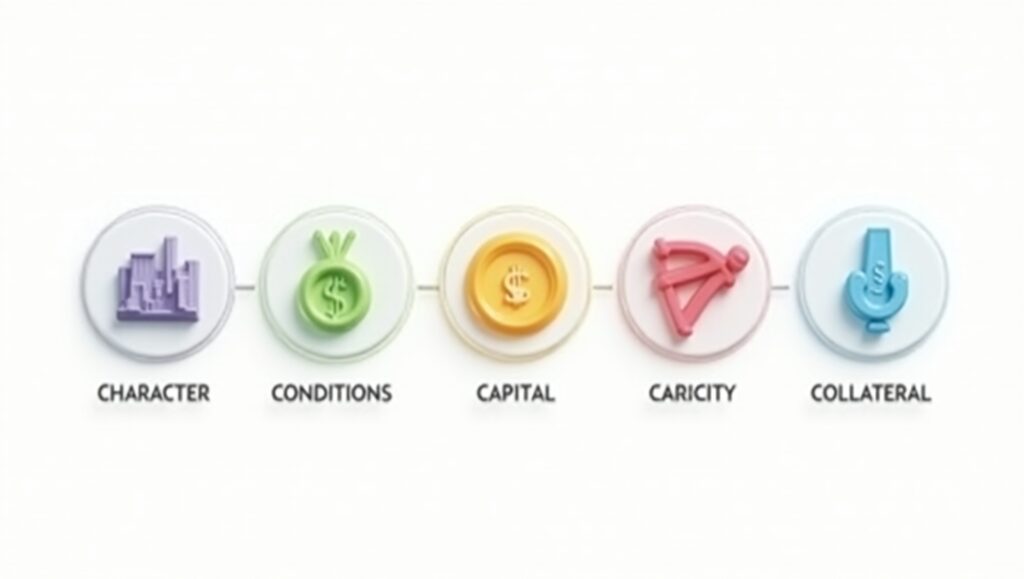
When securing a loan, whether it’s for a new home, land, or a business, one of the most critical processes that lenders follow is underwriting. This is where your financial situation is thoroughly examined to determine whether or not you’re eligible for the loan, and if so, what terms will be offered. But what exactly goes into this process, and how can you prepare?
This post will explore the 5 Cs of Credit—the core factors underwriters use to evaluate your loan application. By understanding these elements, you can better prepare yourself for the underwriting process and increase your chances of loan approval. Let’s dive in!
The Underwriting Process
The underwriting process begins once you’ve submitted all the documentation for your loan application. This information is then sent to a credit analyst who will assess your financial health to determine your eligibility for the loan. The underwriting process involves a detailed analysis of your creditworthiness, and one of the first things the analyst will look at is the 5 Cs of Credit.
These five factors—Character, Conditions, Capital, Capacity, and Collateral—are the criteria lenders use to decide whether to approve your loan and at what terms. Understanding these five components can help you get a clearer picture of how your application will be assessed.
Five Cs of Credit

01. Character: Your Credit History
The first “C” in underwriting is Character, which refers to your credit history and the lender’s assessment of how likely you are to repay your debt. Your credit history provides a glimpse into your financial behavior, showing whether you’ve been a reliable borrower.
To evaluate this, lenders will typically pull a credit report from one of the three major credit bureaus (Experian, TransUnion, or Equifax). Your credit score, which is derived from this report, is an essential factor in this analysis. A strong credit score indicates that you’ve consistently made on-time payments and managed your debt responsibly.
Why Character is Important?
Lenders want to know you can be trusted to meet your financial obligations. Lenders may view you as a higher risk if you’ve defaulted on previous loans, have a history of late payments, or have filed for bankruptcy. However, a clean credit report with timely payments and a good score will work in your favor.
Example: If you’re applying for a home loan and have a solid credit history of paying off previous mortgages, your lender will likely feel more confident in your ability to handle future payments. On the other hand, if you’ve missed several payments or have accounts in collections, the lender may hesitate to approve your loan without further discussion.
02. Conditions: The Economic and Market Environment
The second “C” is Conditions, which refers to the broader economic and market conditions at the time of your loan application. Lenders will assess the market’s stability related to the loan you’re applying for, whether a home, car, or land loan.
For example, suppose you’re applying for a land loan. In that case, the lender will look at the local real estate market, including factors like current property values, market trends, and the potential for future growth or decline in land prices. They’ll also consider your income sources and whether they are stable enough to support your new debt in light of these market conditions.
Why Conditions Are Important?
Lenders want to ensure that the loan is a sound investment, not just for you but also for them. If the market for the property you’re purchasing is volatile or declining, the lender may be more cautious about issuing a loan.
Example: Let’s say you’re buying land in an area where property values have declined for several years. If the trend continues, your lender might worry that the value of the land could fall below the loan amount, making it more difficult for you to sell the property or refinance in the future.
03. Capital: Your Financial Reserves

Next, Capital refers to your financial reserves—the assets you have available to cover your loan repayments and other financial obligations. This includes your savings, investments, and other liquid assets (like stocks or bonds) that could be used to pay down your debt if needed.
Lenders will closely examine your balance sheet, a snapshot of your financial situation showing your assets and liabilities. The goal is to see if you have enough financial Capital to manage the loan if things don’t go as planned. If your income were disrupted or an emergency arose, would you have enough reserves to continue making loan payments?
Why Capital Is Important?
Lenders must know you have enough financial stability to weather unexpected financial challenges. They want to ensure you won’t fall behind on your loan if an emergency arises. Cash reserves can act as a safety net, reassuring you that you can continue making payments even during tough times.
Example: If you have substantial savings in your bank account and a strong investment portfolio, the lender will feel more confident in your ability to handle the loan. On the other hand, if you don’t have significant financial reserves, the lender may require you to provide more documentation or may hesitate to approve the loan.
04. Capacity: Your Ability to Repay the Loan

The fourth “C” is Capacity, which refers to your ability to repay the loan based on your income and other financial obligations. This is where your debt-to-income ratio (DTI) comes into play. It’s a key factor in determining whether you can afford the loan you’re applying for.
The lender will assess both your primary source of income (like your salary or business income) and any secondary sources (such as a spouse’s income, rental income, or other passive income). They’ll evaluate whether you can cover the new loan payment while managing your existing debts, like credit cards, mortgages, and personal loans.
Why Capacity Is Important?
Lenders want to ensure you can handle all your financial obligations without overburdening yourself. A high DTI ratio may indicate that you’re already stretched thin and unable to take on additional debt. On the other hand, a lower DTI suggests that you have enough income to manage your existing debts and still comfortably make your loan payments.
Example: If you earn $5,000 monthly and your monthly debt payments total $2,000, your DTI ratio would be 40%. Suppose you’re applying for a loan, adding $1,000 to your monthly obligations. In that case, the lender will look closely at whether you can handle the new debt without negatively affecting your ability to pay existing bills.
05. Collateral: The Security for the Loan
Finally, Collateral refers to the assets you pledge to secure the loan. In the case of a mortgage, this would be the property you’re purchasing. For a land loan, the land itself typically serves as Collateral.
If you default on the loan, the lender can take possession of the Collateral to recoup their losses. The value of the Collateral is crucial because it determines the loan-to-value (LTV) ratio, which helps the lender assess how much they are willing to lend.
Why Collateral Is Important?
While Collateral is often seen as the “safest” part of the loan for the lender, it is only relevant if you fail to repay it. The lender wants to ensure that, in the worst-case scenario, they can recover the loan’s value from the Collateral.
Example: If you’re applying for a $100,000 land loan and the property you’re buying is appraised at $120,000, the LTV ratio would be 83%. This means the lender is financing 83% of the property’s value, and you would need to come up with the remaining 17% as a down payment.
Final Recommendation
Once all the components of the underwriting process have been evaluated, the credit analyst will provide a recommendation on whether or not to approve the loan. They will weigh each of the 5 Cs of Credit—Character, Conditions, Capital, Capacity, and Collateral—against the loan guidelines and decide based on the overall picture.
The underwriting process ensures that both the lender and borrower make sound financial decisions. It’s not about rejecting loan applications; it’s about making sure that borrowers can afford to repay the loan and that the lender is not taking on unnecessary risk.
Conclusion
Understanding the 5 Cs of Credit is essential for anyone applying for a loan. By knowing what lenders are looking for—whether it’s your credit history (Character), the state of the economy (Conditions), your financial reserves (Capital), your ability to repay (Capacity), or the Collateral you have to back up the loan—you can better prepare yourself for the underwriting process and improve your chances of approval.
If you’re considering a loan, take the time to review your financial situation and ensure that you’re in a good position to meet the lender’s criteria. Being proactive in understanding and improving these five key areas can make all the difference in securing the loan you need on favorable terms.
Got questions about the underwriting process or want to learn more about loan approvals? Feel free to contact a financial expert or your lender for further guidance.

